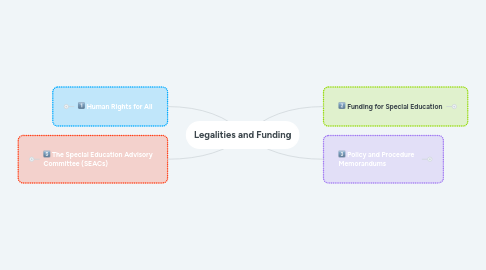Legalities and Funding
da Kaitlyn Stewart


1. Human Rights for All
1.1. "Education of persons with disabilities must foster their participation in society, their sense of dignity and self worth and the development of their personality, abilities and creativity (Article 24)"
2. Funding for Special Education
2.1. FG - Foundation Grant
2.2. Basic level of funding for each student
2.3. SEG - Special Education Grant
2.4. Additional funding for students with special needs. The SEG is composed of the components below.
2.5. SEPPA - Special Education Per Pupil Amount
2.6. The amount is based on total enrollment- not on special education needs. For example, every JK to Gr 3 student gets $1000 per year regards if they need it or not.
2.7. HNA - High Needs Amount
2.8. Provides funding for students with high needs. Formula is based on total enrollment and specific board needs.
2.9. SEA - Special Equipment Amount
2.10. Provides funding for special equipment. There is a funding formula based on total enrollment as well as a claims-based amount.
2.11. SIP - Special Incidence Portion
2.12. Funding for students with very high needs (for example, 2 staff members per student). Funding is based on individual claims
2.13. FA - Facilities Amount
2.14. Provides funding for students in other buildings such as hospitals or correctional facilities (funding is based on program needs)
3. Policy and Procedure Memorandums
3.1. 1
3.2. Schools and resource Centres for Blind and Deaf Requires programming for blind and deaf students Provides guidelines and funding for special schools
3.3. 8
3.4. Identification and Programming for students with Learning Disabilities Defines LDs requires schools to set up procedures for assessment describes appropriate programming and teaching strategies
3.5. 11
3.6. Early Identification of Learning Needs Requires schools to start identifying learning needs as soon as student arrives in a school (i.e., Kindergarten)
3.7. 59
3.8. Psychological Testing and Assessment Requires schools to provide testing and assessment
3.9. 76C
3.10. Alternative Programs and Services for Deaf, Blind Guidelines for programming Deaf-blind students must be supported by an intervener 100% of their day
3.11. 81
3.12. Provision of Health Support Services in School Settings. Outlines procedures and responsibilities for providing health care in school for students who need it
3.13. 85
3.14. Education and Community Partnership. Program Outlines programming, funding and transition plans for students who are not able to be in a school (i.e., hospitals or correctional facilities)
3.15. 140
3.16. Use of Applied Behaviour Analysis (ABA) for students with autism. Provides guidelines for the use of ABA. Programs must be individualized, based on positive reinforcement and collection of data
4. The Special Education Advisory Committee (SEACs)
4.1. Provide important advice on special education to their local board or school authority
4.1.1. May make recommendations to the district school board or school authority respecting matters affecting the establishment, development, and delivery of special education programs and services for exceptional pupils of the board.
4.1.1.1. Participates in the board's annual budget process as it relates to special education
4.1.1.1.1. Reviews the financial statements of the board as they relate to special education
